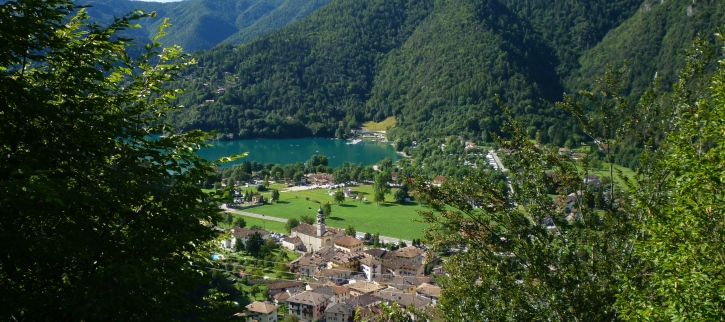
La Valle di Ledro è una valle prealpina del Trentino-Alto Adige appartenente amministrativamente al Comune di Ledro e al Comprensorio Alto Garda e Ledro, nella zona sud occidentale di questa regione, in provincia di Trento. Oltre che per la bellezza dei luoghi, caratterizzati dalla presenza dell’omonimo lago, che richiamano turisti in cerca di natura e tranquillità, la Valle è nota per un episodio che interessò la sua popolazione civile negli anni della Prima Guerra Mondiale. Alla vigilia del conflitto bellico che avrebbe sconvolto l’assetto geopolitico dell’Europa del tempo, il territorio della Valle di Ledro faceva parte, insieme alla regione del Trentino-Alto Adige, dell’Impero austro-ungarico e rappresentava una zona di particolare importanza strategica essendo il confine tra l’Impero austriaco e il Regno d’Italia. Allo scoppio della guerra nel 1914, la popolazione adulta maschile compresa tra i 21 e i 42 anni della Valle fu chiamata alle armi e inquadrata nel XIV Corpo d’Armata schierato in Galizia e sui Carpazi, sul fronte orientale. Nelle ore di poco precedenti a quella sera del 23 maggio del 1915 in cui Vittorio Emanuele III, Re d’Italia, annunciava alle forze armate italiane di aver dichiarato guerra all’Austria-Ungheria schierandosi con i paesi dell’Intesa, gli austriaci, già da tempo convinti che l’Italia non avrebbe mantenuto a lungo la sua neutralità e consapevoli che i primi scontri con gli italiani sarebbero avvenuti proprio nella zona della Valle di Ledro, si mobilitarono per ultimare la creazione di una linea di difesa in questa zona dove vennero costruite imponenti opere militari di sbarramento per fermare il passo dell’esercito italiano che sarebbe arrivato da Sud. A causa della pericolosità della situazione, gli austriaci diedero l’ordine di evacuare tutta la popolazione civile dai territori che di lì a poco sarebbero diventati campo di battaglia tra i due schieramenti. Il 22 maggio del 1915, sulle pareti delle case della popolazione ledrense, venne affissa la Notificazione dell’Imperial Regio Capitano di Riva che ordinava l’evacuazione per tutta la popolazione della Valle, da effettuarsi entro 24 ore. Il 23 maggio del 1915, giorno di Pentecoste, nel giro di poche ore, migliaia di persone, in prevalenza donne, bambini ed anziani, furono costretti a lasciare le loro case e quella che fino a quel momento era stata tutta la loro vita, per una destinazione e un futuro ignoti. Tutto quello che gli fu concesso portare con sé, furono un bagaglio e i viveri necessari per alcuni giorni di viaggio. Questo vero e proprio esodo di massa coinvolse in totale circa 75.000 persone che da tutto il Trentino furono spostate nelle regioni interne dell’Impero: Austria, Moravia, Boemia; regioni per loro lontane, di lingue e culture diverse. Di queste persone, 11.400 circa, provenienti in prevalenza dalla valle di Ledro, arrivarono in Boemia. Se si considera che molta di quella gente non era mai prima di allora uscita dalla Valle, si può forse capire il dramma psicologico che gli sfollati dovettero sostenere. La popolazione venne caricata su camion, treni e carri e trasportata per giorni lungo centinaia di chilometri in condizioni estreme e, una volta giunta in territorio boemo, distribuita tra le famiglie ceche dei comuni di Buštehrad, Chynava, Doksy, Dřetovice, Nový Knin, Milin, Přibram, Ptice, Svárov, Železná, Všeň e Stříbro; paesi dai nomi impronunciabili e di cui i trentini non conoscevano la lingua. I ledrensi furono accolti dalla popolazione boema e morava dapprima con curiosità e diffidenza e furono sistemati alla meglio in palestre e scuole trasformate in dormitori, o presso famiglie boeme. La promessa austriaca di una permanenza che doveva durare soltanto poche settimane, venne disattesa e gli italiani capirono presto che in quelle terre lontane dalla propria casa sarebbero rimasti per un tempo indeterminato e avrebbero dovuto iniziare da capo a costruirsi un’esistenza degna. Così, senza mezzi economici e senza conoscere la lingua locale, i ledrensi dovettero reinventarsi un’esistenza combattendo, almeno all’inizio, contro un insidioso nemico: la fame. I primi tempi furono molto duri anche a causa delle differenze linguistiche che all’inizio impedivano la comunicazione. Molti, per sfuggire alla fame, mangiavano le rane pescate negli stagni e qualsiasi cosa fosse commestibile, ma poco a poco, la diffidenza iniziale della popolazione boema e la differenza linguistica furono superate grazie alla laboriosità e alla modestia degli italiani che da subito cercarono di rendersi produttivi e di guadagnarsi il rispetto e la stima dei cechi che non tardarono a manifestarsi, forse anche a causa del risentimento che i due popoli provavano contro il comune oppressore. Successivamente, ai profughi venne assegnato un contributo giornaliero in denaro pari a 70 haler che scongiurò i problemi più urgenti di sussistenza. Le donne italiane furono impiegate nei campi carenti di manodopera a causa della guerra e, con il loro duro lavoro, si guadagnarono l’affetto e il rispetto della popolazione locale. I bambini furono i primi ad imparare la lingua perché giocavano con i loro coetanei cechi e aiutarono presto i genitori a comunicare con la popolazione locale. Se da una parte il soggiorno boemo fu per i ledrensi un esilio forzato, è anche vero che questo esilio si trasformò in una storia di grande solidarietà e di amicizia che poco a poco nacque tra gli italiani e i cechi. Nel cuore dei profughi la parola “Boemia” era sinonimo di esilio, ma qui gli italiani continuarono a mantener vive le proprie tradizioni riuscendo ad integrarsi con la popolazione locale e a stringere con essa sinceri e duraturi rapporti di stima, rispetto e amicizia reciproci. Nel corso degli anni, mentre sul fronte italiano infuriava la guerra, in Boemia le donne trentine continuarono ad occuparsi della famiglia aspettando speranzose il ritorno dei figli e dei mariti dal fronte. Quando l’esercito italiano riuscì ad occupare i paesi della Valle, il 4 novembre del 1918 le ostilità cessarono e il regio esercito italiano ormai entrato a Trento issò il Tricolore sulle alture fino a poco tempo prima occupate dal nemico. Alla luce della nuova situazione, i profughi, dopo quattro anni in terra boema, poterono far ritorno alla proprie case insieme ai soldati che tornavano dal fronte. Ma se l’arrivo in Boemia era stato traumatico, lo fu altrettanto il doversi separare dagli amati cechi, ormai amici, che avevano permesso ai ledrensi di sopravvivere in quei duri anni. I rapporti di stima ed amicizia allacciati erano destinati a durare per sempre. Al ritorno a casa, i profughi e i soldati superstiti finalmente si ritrovarono: le mogli poterono riabbracciare i loro mariti e le madri i proprio figli, ma i paesi nei quali facevano ritorno erano spesso ridotti a un cumulo di macerie, le case scoperchiate, i campi distrutti e disseminati di proiettili inesplosi. Ai ledrensi non restò altro che iniziare nuovamente da capo, con nuova forza e grande dignità, per ricominciare a vivere normalmente. I ledrensi ricordarono, e i loro discendenti ricordano ancora oggi, l’esodo in Boemia con profonda gratitudine nei confronti del popolo ceco e più volte negli anni successivi, dopo la Seconda Guerra Mondiale, tornarono in segno di riconoscenza nei paesi che li avevano ospitati alla ricerca dei loro vecchi amici e per visitare nei cimiteri boemi le tombe dei loro cari: parenti e connazionali deceduti in quella terra lontana. Ancora nel 2009, a quasi un secolo dall’esilio nell’attuale Repubblica Ceca, è stato siglato per volontà dell’amministrazione della Valle di Ledro, un gemellaggio in segno di amicizia tra i Comuni della Valle: Molina, Pieve, Bezzecca, Concei, Tiarno di Sotto e Tiarno di Sopra, con otto Comuni cechi: Buštěhrad, Chyňava, Doksy, Milín, Nový Knín, Příbram, Ptice e Všeň, a ricordo di quell’esperienza e in segno di reciproca e perpetua amicizia. In tale occasione sono stati anche pubblicati il libro: “Boemia. L’esodo della Val di Ledro 1915 – 1919” curato da Dario Colombo, e un DVD che narrano nei particolari la vicenda e raccolgono le testimonianze dirette di questa pagina poco conosciuta della storia del nostro Paese.
Ogni guerra, giusta o meno che sia, rappresenta sempre un evento drammatico che non conosce né vinti, né vincitori, ma spesso è proprio in tempi di barbarie e in situazioni simili che l’essere umano riesce a dare il meglio di sé stesso e a dare prova di grande solidarietà verso i propri simili. L’esodo in Boemia dei profughi trentini è una pagina di storia e un esempio che ci dimostra quanto ciò sia vero e quanto l’amore per la vita vada oltre ogni distinzione di razza, lingua e nazionalità.
(Questo articolo di Mauro Ruggiero è stato pubblicato su: Progetto Repubblica Ceca, settembre-ottobre 2011)

Bohemia – Ledro Valley 1915 – 1919. Story of an exodus and a friendship.
The Ledro valley is a pre-Alpine valley, located in the Trentino-Alto Adige area, which is under the administration of the Ledro Council and forms part of the Upper Garda and Ledro district, in the south west of the region in the province of Trento. Besides the extreme beauty of the area, characterized by the well known homonymous lake, that attracts numerous tourists in their search for natural surroundings and tranquillity, the Valley is also known for an episode that involved its civilian population during the First World War. On the eve of the armed conflict, that was to change the geopolitical composition of Europe, the Ledro valley territory, along with that of the Trentino-Alto Adige region, formed part of South Tyrol region – the Austro-Hungarian Empire, which was an area of particular strategic importance, as it marked the border between the Austrian Empire and the Kingdom of Italy. At the outbreak of war in 1914, the adult male population of the Valley, between the ages of 21 and 42, was called to arms and assigned to the XIV Army Corps deployed in Galicia and on the Carpathians, on the Eastern front. A few hours before the evening of May 23rd 1915, when Vittorio Emanuele III, King of Italy, announced to the Italian armed forces that he had declared war on Austria-Hungary, by siding with the Entente Countries, the Austrians (who had already expected that Italy would not maintain its neutrality for long and who were aware that the first clashes with the Italians would take place in the Valley of Ledro), decided to mobilize their troops to complete the military stronghold they had been building in this area with a large military defence system, in order to stop the Italian army coming from the south. Because of the extremely dangerous impending situation, the Austrians ordered the evacuation of all civilians from the territory, that was soon to become the main battlefield. On 22nd May 1915, a royal edict by Captain Riva was affixed on the walls of the Ledro houses, ordering the evacuation of the entire population from the Valley within 24 hours. In just a few hours, on 23rd May 1915, on the day of Pentecost, thousands of people, consisting mostly of women, children and elderly people, were forced to leave their homes, belongings and all that had been formed part of their ordinary lives, to move to an unknown destination and venture into the unknown. They were only allowed to take some luggage with them and just enough food for a few days’ march. The really massive exodus that followed, involved around 75,000 people from all over the Trentino area, who were moved to the inner regions of the Empire: Austria, Moravia, and Bohemia: far away regions, consisting of different languages and cultures. Approximately 11,400 of them arrived in Bohemia, mostly from the Ledro Valley. If we consider that many of those people had never left their own valley before, it is, perhaps, easy to understand the deep psychological trauma the evacuees had been subject to. They were placed onto lorries, trains and carts and transported over hundreds of miles for days in extremely difficult conditions and – once on Bohemian territory – they were assigned to different families in the Czech Municipalities of Buštehrad, Chynava, Doksy, Dřetovice, Nový Knin, Milin, Přibram, Ptice, Svárov, Železná, Všeň and Stříbro; villages with unpronounceable names, and with a language that the Trentino people could not understand. Initially, the Ledro people were welcomed by the Bohemian and Moravian population with a sense of curiosity and suspicion and were housed in the best gyms and schools that had been converted into dormitories, or were placed in Bohemian homes. The Austrians promise, that it would only last a few weeks, was not honoured and the Italians soon became aware that they would have remained far from their homeland for an indefinite amount of time and had to start from scratch to build up a decent life. Therefore, with no economic means, and without knowing the local language, the Ledro Inhabitants had to reinvent a new life by struggling, at least during the first phases, against an insidious enemy: lack of food. The first period was extremely demanding, also because of the language difference that during in the first phases, at least, prevented any form of communication. To escape from hunger, many of them ate frogs they were able to catch in ponds and anything else that was edible. But, little by little, the initial distrust of the Bohemian population and differences in language were surmounted, also thanks to the hard work and modesty of the Italians, who did their best to be productive and soon earned the respect and esteem of the Czechs, which was slow in coming, though, perhaps due to the amount of resentment the two populations felt against their common oppressor. Some time later, the refugees were given a daily cash contribution, amounting to 70 haler, which helped to cope with the most urgent subsistence needs. The Italian women were employed in those fields that required extra labour, because of the war and, thanks to the hard work, they were able to earn the affection and respect of the local population. Their children were the first to learn the language, because they played with their Czech peers and this over time also helped their parents to communicate with the local population. If this experience in Bohemia was seen as an enforced exile by the Ledro population, it is also true, however, that it also proved to be an extraordinary experience of great solidarity and friendship between the Italians and the Czechs, that became greater and greater over time. In the heart of the refugees, the word “Bohemian” was synonym of exile, but all the same, the Italians were able to maintain and preserve their traditions, they were able to integrate with the local population and build up sincere and lasting relationships of mutual respect and friendship. Over the years, while on the Italian front the war was still raging, in Bohemia, the Trentino women took care of their families while they waited hopefully for the return of their sons and husbands from the front. When the Italian army finally managed to reoccupy the towns of the Valley, on 4th November 1918, hostilities ceased, and the Royal Italian army finally hoisted the tricolour flags up on the high grounds that, until a short time before, had been occupied by the enemy. In view of these new circumstances, after four years on Bohemian land, the refugees were able to return to their homes, together with the soldiers coming back from the military front. But if the arrival in Bohemia had been traumatic, it was also very hard to part from the beloved Czechs, who had now become their friends and who had helped them to survive throughout those very difficult years. The relationships, made up of mutual respect and friendship, were destined to last forever. On their arrival home, the surviving refugees and soldiers finally met up again: the wives could embrace their husbands, the mothers their sons. But the villages they had returned to were often rubble, the houses roofless, the fields destroyed and full of unexploded shells. The Ledro population was obliged to start all over again, with goodwill and great dignity, in order to begin a new life. Even today, the Ledro people and their descendants still remember their Bohemian exodus with deep gratitude towards the Czech population and many times, during the years that followed the Second World War, they went back there as a sign of gratitude towards those villagers that had given them shelter and hospitality, in search of their old friends and to visit the graves of their beloved ones in Bohemian cemeteries: relatives and fellow-countrymen, who had died in that far away land. Even in 2009, almost a century from that exile, a Twinning agreement was signed in the Czech Republic, by will of the Ledro administration, as a sign of friendship by the towns of the Valley: Molina, Parish, Bezzecca, Concord, Tiarno di Sotto and Tiarno di Sopra, with eight Czech municipalities: Buštěhrad, Chyňava, Doksy, Milin, Nový Knin, Příbram, Ptice and Všeň, in memory of that experience and as a sign of mutual and perpetual friendship. On that occasion a book was published entitled “Bohemia. the Ledro Valley Exodus 1915 – 1919 “, edited by Dario Colombo, as well as a DVD that recounts, in great detail, the story and bear witness to this little-known chapter in the history of our country.
Every war, whether just or unjust, is always a dramatic event that knows neither winners nor losers, but often, it is precisely in times of barbarity and similar situations of cruelty that human beings tend to give the best of themselves and show great solidarity towards their fellows. The exodus to Bohemia by the Trentino refugees is a chapter of history and a vivid demonstration of this fact – and goes to show – that love for life goes beyond all distinctions of race, language or nationality.
(By Mauro Ruggiero, from: Progetto Repubblica Ceca, October 2011)






